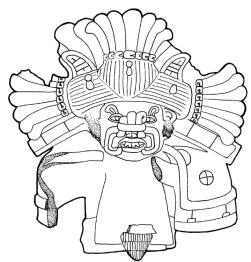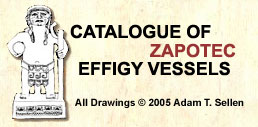| Key: MSMA 1993.23.3 | | Actual Location: Site Museum, Monte Albán, Oaxaca, Mexico. | | Registration: Burial 1993-23, no. 3, Monte Albán. | | Provenance: South platform, West side, structure PSLP-S2, square 17, Monte Albán, Oaxaca. | | Measurements: 30 x 25 x 24 dia. cm. | | Color: Beige clay | | Chronology: MA IIIB-IV (Winter et al. 1995:126); Xoo 600 - 800 AD | | Click to view Chronology | | Reference: Winter et al. 1995: 126-127. figs. 33b, 34a, 35b. | | Comments: This piece was found in a grave associated with a skeleton and a bat's claw vessel. According to Winter the grave was looted in pre-Hispanic times and these pieces were removed. The effigy vessel was found in two pieces, at different ends of the tomb. When the piece was found the figure was holding a bag of incense (see excavation photo, Winter et al. 1995: 127) but the report does not describe this fragment and it is currently without it. The figure is wearing a mouth mask (type 2). To compare this piece with another, more complete, see SOTH 1976.147. | |
| | 
Click to view high resolution in a new window
select this image for review |
